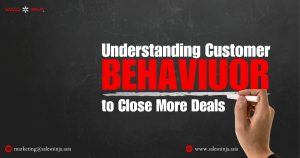In the same way, the Malaysian government has been flip-flopping between English and Bahasa Malaysia for the language of core subjects, the trend in sales has been going back and forth from physical stores to online sales. Now, this trend is slowly retracing its steps to boost sales through the physical stores– take Taobao and its opening of huge physical stores in Singapore and Malaysia. How do you navigate these changes in 2020 as both a B2B and B2C business? Here’s how –
5 TIPS FOR B2B SALES
1. Follow up, follow up and follow up again.
One of the biggest mistakes salespeople make is not following up! Even worse? Following up only after the lead goes cold. This may seem like a recurring point but you’d be surprised how often this step is avoided! Reports have shown that it now takes 18 dials to connect with buyers, who now require more applicable and tailored connections. A separate report by Hubspot has shown that 80% of sales require for or more calls before closing. What makes this worse is that additional data by Marc Wayshak has shown that only 15% of salespeople have broken through the prospect threshold of “1,000 prospects reached” in the past year. What more about following up with the ones they’ve actually connected with? Don’t miss opportunities just because you’ve heard “no” or “I’m not interested”.
2. Utilise both online and offline platforms
Set up solid accounts on the internet and a physical office for people to come and meet you in person. Previously, consumers only had the choice of physical stores that they had to personally visit to get what they wanted. Now, they have the benefit of online shopping and delivery services (GrabMart and Happy Fresh) to deliver your goods directly to your doorstep. At present, buyers depend heavily on search results, vendor websites, and newsletters/emails for information before actually approaching salespeople as a prospect. At this point, they are considering your product or service for the purchase and are rarely looking for more product information as they are focused on pricing. Why not get the best of both worlds by solidifying your search engine ranking with a comprehensive website and offering a face-to-face meeting to provide a personal, customized experience?
3. Don’t be afraid to get creative
In sales in 2020, there is a fine line between being stoically professional and approachable professional. Imagine this: you’re in a coffee shop and two different salespeople approach you at different times. One is cool, shows little facial or tonal emotion, and is formal to the bone. The other approaches you with a smile, injects emotions into his/her face and tone as well as uses more comfortably affirmative language. Which salesperson are you more likely to warm up to? In the same way, businesses need to change their approach (both offline and online) to emotionally appeal to their customer base. This is important because people are buying into your persona rather than the product right off the bat. Do this by being unique – create curiosity by making them go “huh?” (“But I’ve never heard of that?”) rather than “aha!” (“Aha, another salesperson”).
4. Keep a folder of buyer personas
Now, how can you understand your market and clients? By creating general profiles of the different types of customers and clients that are part of your market base. These could include both positive and negative buyer personas. Positive ones are the client types that are most likely to engage in your products or services. Negative buyer personas refer to low-quality leads (with high acquisition costs, low ROI, or goals that you cannot reach presently) that would help your sales team reduce their time lost and opportunity costs. The same data from Wayshack shows that 71.5% of respondents found that 50% or fewer prospects are actually suitable for their products or services.
5. Sell by account
With the experience, expertise, and systems in place to do so, sales are taking big steps towards account-based selling. What this means is more in-depth, detailed selling based on each clients’ needs. Already, 75% of B2B companies are adopting account-based marketing tactics. This is because, in doing so, you are customizing your product or service for that “one” client. It can be as simple as changing the framework for your pitch to hit the right pain points for each customer. In both marketing and in the actual sales pitch, personalized efforts will allow for the product and/or service to seem like the best (and only) option for them.
5 TIPS FOR B2C SALES
1. Listen to your customer base
The best way to know what the market needs is to listen to the market. There is no point in forecasting and creating 5-year plans if you do not know what the customer wants in the here and now. Plans are easy to botch when they are inapplicable to the present, much less the future. The easy way to do this is to behave in the way you would expect your customers too. Mirror their speech and their body language and you have a 67% chance of reaching an agreement! This is because you are creating familiarity and at the same time, you are building a bond of trust. Alternatively, if your customer base prefers online buying, listen to them and utilize social media – Facebook Marketplace, Instagram profiles, Carousell. Engaging in social selling can increase your revenue by 16% and if you’re a social selling genius who listens to his/her customer base, you could triple that number.
2. Grow offline as well as online
If you have the financial capabilities, set up solid accounts on the internet as well as a physical office for people to come and meet you in person. Previously, consumers were more likely to indulge in cheaper products while taking a risk on quality. Current trends show that the newer generations (Millennials, Gen Z) are more conscious of their spending – preferring to spend extra on products that are certified to be of good quality than saving only to get a less than satisfactory product or service. If you’re starting out and don’t have the capital for a whole office, make use of the various roadshows, markets, and campaigns in malls, colleges, or open spaces that allow vendors to rent space to sell their own products and services.
3. Cut through the noise
More and more consumers are evolving and becoming sellers themselves. That means that the market is slowly becoming saturated with people who want to sell and market their own products. The numbers are crazy –
A new profile is created on Facebook every 6 seconds
There are 1.3 billion Twitter accounts with 6,000 tweets sent out every second
Over 95 million photos are uploaded onto Instagram each day
More than 3 million companies have LinkedIn accounts
And the statistics grow each day. To ensure that they are being seen, B2C companies tend to be on every single possible platform that will profit them. However, in doing so they are stretching themselves thin and creating noise that customers do not want to engage in. The systematic way to cut through the noise is to choose 2 – 3 channels of communication and focus 90% of your marketing through these. The other channels can be used to monitor activity and trends but should not also take up as much time as the chosen 2 – 3. In doing so, you can emphasize showcasing your brand’s personality, USPs and increasing engagement
4. Practise B2B Tactics
While not every technique is transferrable or scalable, there is a lot to learn from B2B companies. For one, the follow-up discipline in the B2B industry is very important in a B2C environment because the foundation is the same – you want to appeal to people constantly (without appearing to spam them). In the same way, a faster follow up can increase your sales potential by as much as 60 times more than people that respond an hour after receiving the inquiry. Not to mention, in the same way, B2B companies search for prospects outside the ones that have already contacted them, place yourself in the very middle of conversations that are relevant to you and your brand to generate awareness and increase views. You don’t have to comment with anything lengthy (it can be something way under the Twitter limit) or overly witty, it can be simple and straight to the point.
5. Believe
Believe in yourself and your product. In a B2C environment, customers will be able to see through your façade if you are selling for the sake of reaching targets and making a profit. This is because your selling techniques will change according to your own agenda. With more and more customers wanting a more personalized buying experience, it is beneficial to believe in the product because you will then be more capable of selling to suit needs rather than selling to suit your sales target. At the same time, you need to believe in your own abilities and be able to occasionally give yourself constructive criticism. Your belief in yourself and your product will allow you to take your weaknesses and work towards turning them into strengths.
BONUS SALES TIP
No matter if you’re in B2B sales or B2C sales, there is one step that will help almost double your sales if done right –
ASK FOR REFERRALS!
Only 18.6% of salespeople are asking for referrals – imagine the opportunity cost of each referral they don’t ask for? To give you an idea, 84% of buyers now buy based on referrals, with 92% trusting referrals from people they know. When measured in terms of marketing, 78% of referral programs generate good or excellent leads in high volume with 54% agreeing that referrals have lower cost-per-lead. So what are you waiting for?




